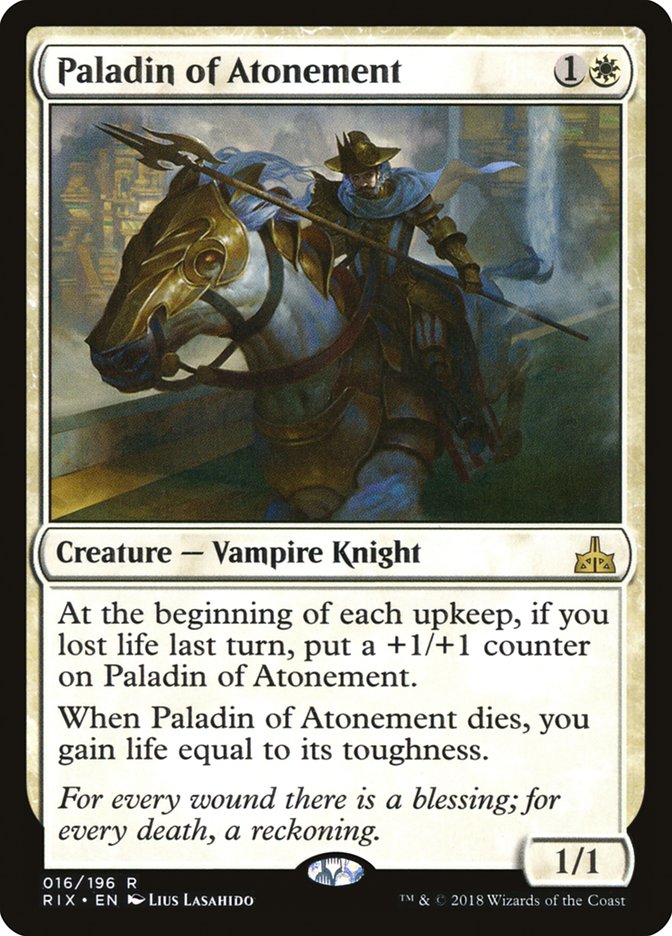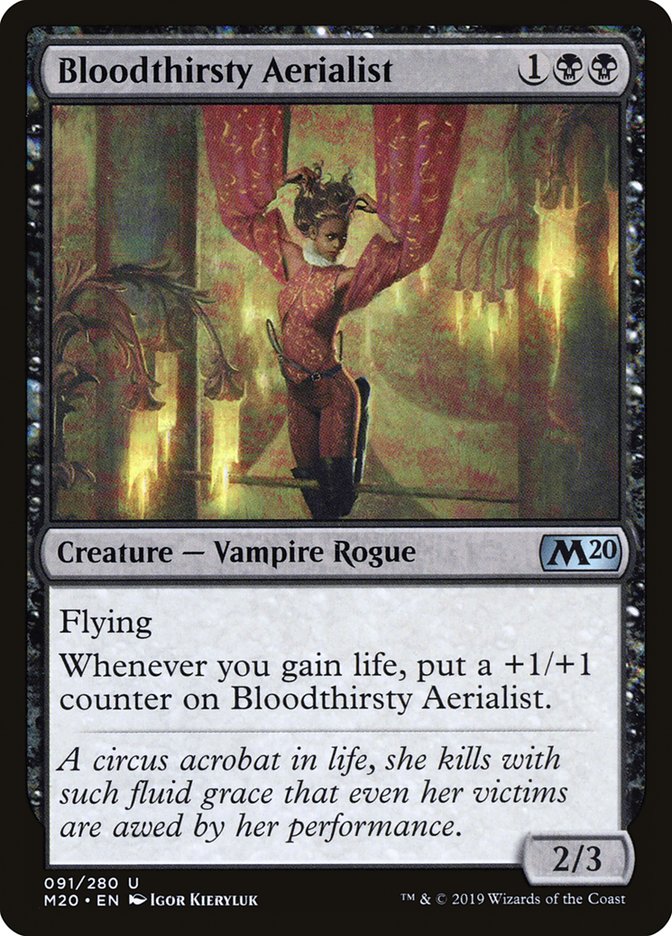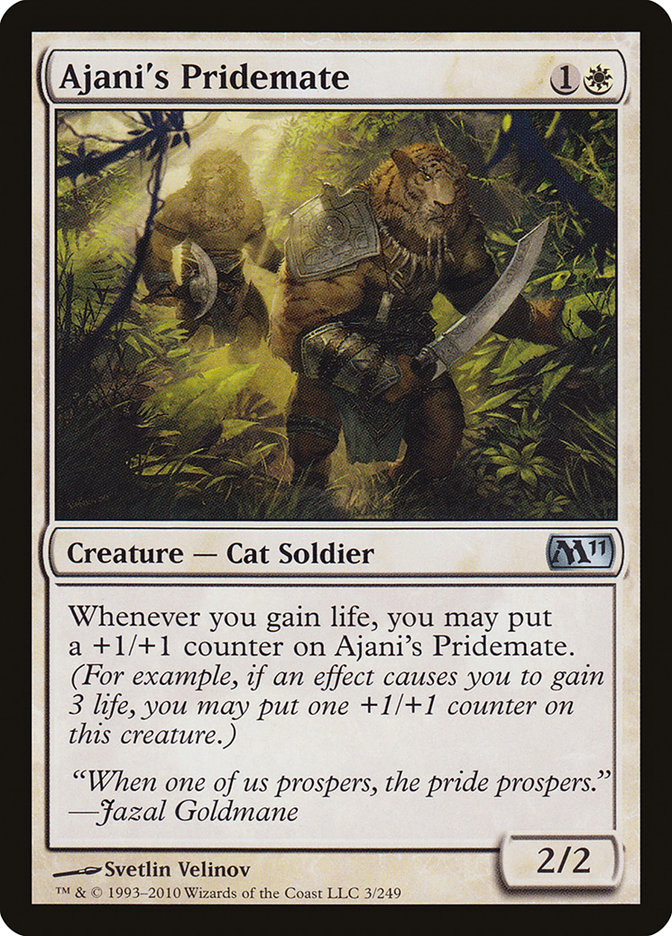Paladin of Atonement MTG Card
| Mana cost | |
| Converted mana cost | 2 |
| Rarity | Rare |
| Type | Creature — Vampire Knight |
| Released | 2018-01-19 |
| Set symbol | |
| Set name | Rivals of Ixalan |
| Set code | RIX |
| Power | 1 |
| Toughness | 1 |
| Number | 16 |
| Frame | 2015 |
| Layout | Normal |
| Border | Black |
| Illustred by | Lius Lasahido |
Text of card
At the beginning of each upkeep, if you lost life last turn, put a +1/+1 counter on Paladin of Atonement. When Paladin of Atonement dies, you gain life equal to its toughness.
For every wound there is a blessing; for every death, a reckoning.
Cards like Paladin of Atonement
The Paladin of Atonement card is an interesting character in MTG, often compared to other creatures that grow stronger over time or through specific gameplay conditions. Like Bloodthirsty Aerialist, it gains benefits from your loss of life, with the aerialist also gaining a +1/+1 counter whenever you gain life. Contrarily, the Paladin only grows when you lose life during your turn, reflecting how each card presents a different strategic approach to the life mechanics within the game.
Another similar card is Ajani’s Pridemate, a well-known creature for those favoring life gain strategies. While Ajani’s Pridemate gains strength each time you gain life, rather than when losing it, it parallels Paladin of Atonement’s ability to become a significant threat if left unchecked. However, the Paladin’s endgame is quite distinct, providing a lifeline by granting you life equal to its size at the moment of its demise, potentially swinging the game’s momentum in your favor.
Each of these cards presents their own advantages within the MTG universe, and while Paladin of Atonement may require a more nuanced strategy to unlock its full potential, its unique mechanics can serve as a cornerstone for decks built around life manipulation.
Card Pros
Card Advantage: Paladin of Atonement has a unique mechanism that lets it accumulate +1/+1 counters whenever you lose life. This can potentially lead to significant card advantage, especially in formats where life loss is a frequent strategy, helping to maintain a stronger presence on the board.
Resource Acceleration: While not directly providing mana, the ability of this card to grow in power at a constant rate effectively increases the value of the resources you have on the battlefield. Each point of life lost is turned into increased offensive and defensive capabilities, thus accelerating your resource efficiency.
Instant Speed: Although the card itself doesn’t operate at instant speed, its ability to interact with instant-speed cards is noteworthy. Life loss from instant speed spells or abilities at the end of your opponent’s turn can beef up the Paladin right before your turn, surprising an opponent who might have underestimated its power.
Card Cons
Discard Requirement: While Paladin of Atonement does not directly require you to discard cards, its main ability to gain +1/+1 counters is contingent upon having lost life in the preceding turn. This can sometimes force players to make suboptimal plays or trades to ensure that the condition is met.
Specific Mana Cost: As a card that requires both white mana and one other mana to cast, Paladin of Atonement may not seamlessly slot into multicolored decks that aren’t focused on white mana. Its mana requirements can also make it challenging for players to diversify their deck’s color base effectively.
Comparatively High Mana Cost: Though its casting cost is moderate, the requirement of losing life to trigger Paladin of Atonement’s ability may necessitate supplemental cards or strategies, which implicitly elevates the overall mana investment to utilize this card to its full potential.
Reasons to Include in Your Collection
Versatility: Paladin of Atonement fits well in a variety of deck archetypes that focus on life total manipulation. This card can serve both offensive and defensive roles depending on your board state and matchups.
Combo Potential: This card gets stronger as you lose life, making it a natural pair with effects that cause life loss for an upside. It can also synergize with cards that grant you life upon death, further enhancing its utility.
Meta-Relevance: In metas where aggro decks are prevalent, Paladin of Atonement can act as a deterrent, growing in response to the damage you take and becoming a threat that must be dealt with, improving its utility and relevance in such scenarios.
How to beat
Within the strategy-driven world of Magic: The Gathering, facing off against a Paladin of Atonement can present a unique challenge. This vampire knight, thriving on taking hits to bolster its strength, requires a tactical approach to overcome. To beat Paladin of Atonement, it’s crucial to minimize the incremental life loss it capitalizes on, which boosts its power each turn. Tactics such as inflicting damage in large bursts rather than small increments can prove effective, rendering the Paladin’s ability less impactful.
Moreover, utilizing removal spells that don’t deal direct damage but still remove the creature from play, such as Path to Exile or Murder, can circumvent the Paladin’s strength-gaining mechanism altogether. Preventing its death trigger, which grants life equal to its power, ensures it doesn’t leave lasting repercussions after it’s dealt with. Preventing your own life loss, denying it counters, or employing instant-speed removal before the life gain and counters are received at the beginning of your upkeep are ways to smartly navigate around this resilient adversary.
Ultimately, mastering the subtle art of timing and choosing the right removal options can shift the odds in your favor, allowing you to dismantle Paladin of Atonement’s advantage and keep control of the battlefield.
Where to buy
If you're looking to purchase Paladin of Atonement MTG card by a specific set like Rivals of Ixalan, there are several reliable options to consider. One of the primary sources is your local game store, where you can often find booster packs, individual cards, and preconstructed decks from current and some past sets. They often offer the added benefit of a community where you can trade with other players.
For a broader inventory, particularly of older sets, online marketplaces like TCGPlayer, Card Kingdom and Card Market offer extensive selections and allow you to search for cards from specific sets. Larger e-commerce platforms like eBay and Amazon also have listings from various sellers, which can be a good place to look for sealed product and rare finds.
Additionally, Magic’s official site often has a store locator and retailer lists for finding Wizards of the Coast licensed products. Remember to check for authenticity and the condition of the cards when purchasing, especially from individual sellers on larger marketplaces.
Below is a list of some store websites where you can buy the Paladin of Atonement and other MTG cards:
 BUY NOW
BUY NOW BurnMana is an official partner of TCGPlayer
- eBay
- Card Kingdom
- Card Market
- Star City Games
- CoolStuffInc
- MTG Mint Card
- Hareruya
- Troll and Toad
- ABU Games
- Card Hoarder Magic Online
- MTGO Traders Magic Online
See MTG Products
Legalities
Magic the Gathering formats where Paladin of Atonement has restrictions
| Format | Legality |
|---|---|
| Historicbrawl | Legal |
| Historic | Legal |
| Legacy | Legal |
| Oathbreaker | Legal |
| Gladiator | Legal |
| Pioneer | Legal |
| Commander | Legal |
| Modern | Legal |
| Vintage | Legal |
| Duel | Legal |
| Explorer | Legal |
| Penny | Legal |
| Timeless | Legal |
Rules and information
The reference guide for Magic: The Gathering Paladin of Atonement card rulings provides official rulings, any errata issued, as well as a record of all the functional modifications that have occurred.
| Date | Text |
|---|---|
| 2018-01-19 | Paladin of Atonement’s first ability cares only whether you lost life last turn, even if Paladin of Atonement wasn’t on the battlefield when that happened. It doesn’t care how much you lost, whether you also gained life, or even whether you gained more life than you lost. |
| 2018-01-19 | To determine how much life you gain for the last ability, use Paladin of Atonement’s toughness as it last existed on the battlefield. If its toughness was less than 0, you won’t gain life. (You also won’t lose life.). |


